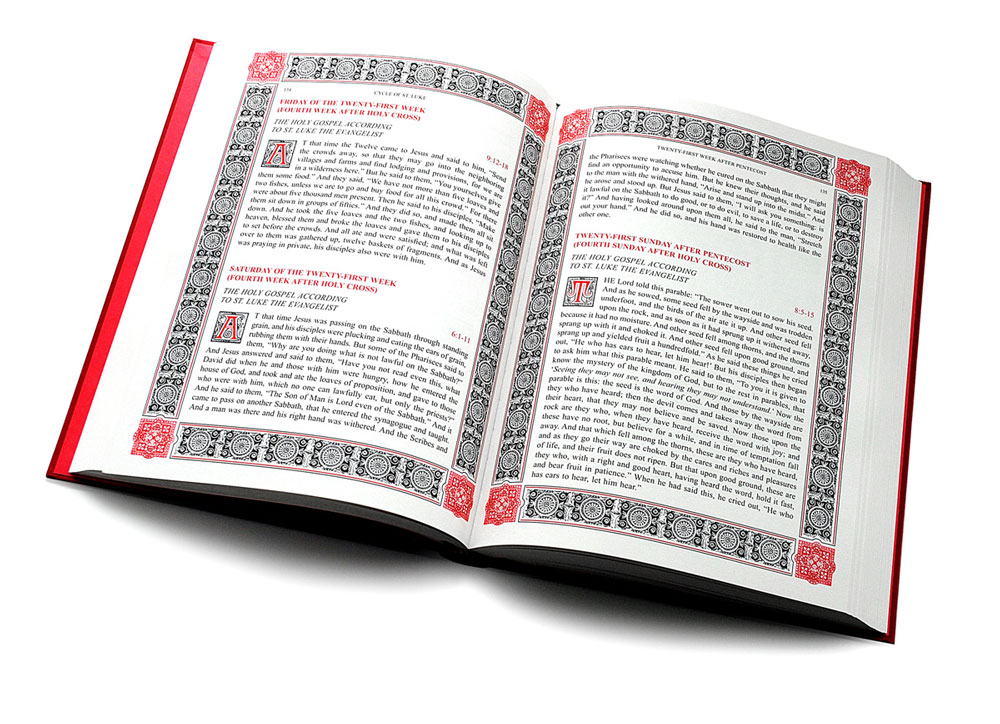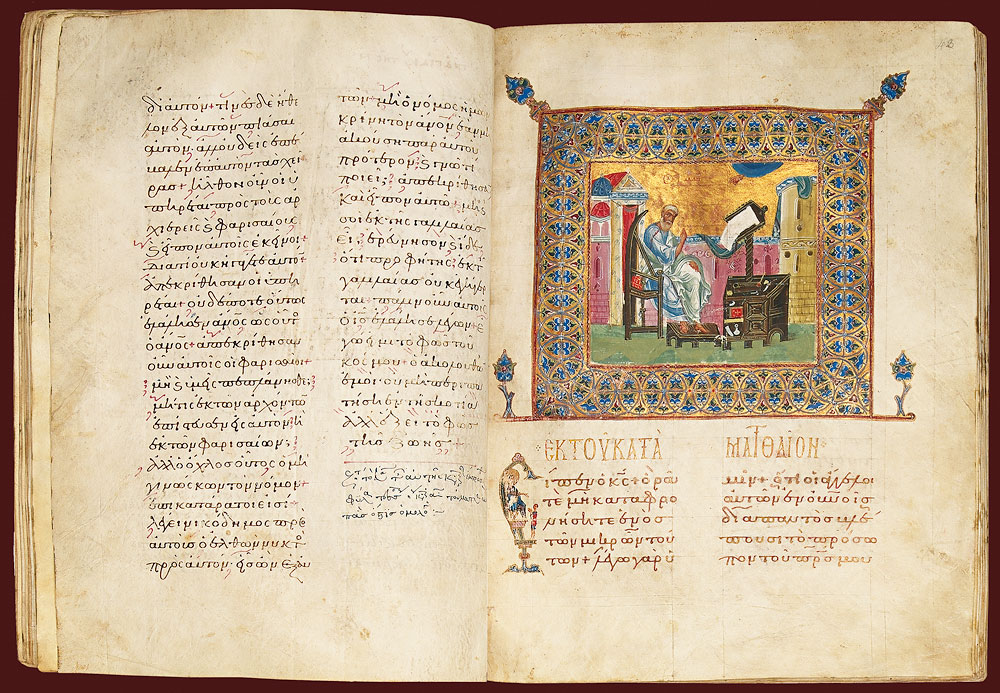A Lectionary is a book or listing that contains a collection of
scripture readings appointed for
Christian or
Judaic worship on a given day or occasion.
History
In antiquity the Jews created a schedule of scripture readings assigned to be read in the synagogue. Selections were read from the Torah and the haftorah. Jesus likely read one of these pre-assigned readings when he read from Bible verse |Isaiah|61:1-2|HE, as recorded in Bible verse |Luke|4:16-21|KJV, when he inaugurated his public ministry. The early Christians adopted the Jewish custom of reading extracts from the Old Testament on the sabbath. They soon added extracts from the writings of the Apostles and Evangelists.
Both Hebrew and Christian lectionaries developed over the centuries. Typically, a lectionary will go through the scriptures in a logical pattern, and also include selections which were chosen by the religious community for their appropriateness to particular occasions.
The use of pre-assigned, scheduled readings from the scriptures can be traced back to the
early church. Not all of the Christian Church used the same lectionary, and throughout history, many varying lectionaries have been used in different parts of the Christian world. Until the
Second Vatican Council, most Western Christians (
Roman Catholics,
Old Catholics,
Anglicans,
Lutherans, and those
Methodists who employed the lectionary of
Wesley) used a lectionary that repeated on a one-year basis. This annual lectionary provided readings for Sundays and, in those Churches that celebrated the festivals of
saints, feast-day readings. The
Eastern Orthodox Church and many of the
Oriental Churches continue to use an annual lectionary.
Lectionaries from before the invention of the [printing press] contribute to understanding the textual history of the Bible. See also
List of New Testament lectionaries.
Western Lectionaries
The Roman Lectionary and the Revised Common Lectionary
The roots and history of the Revised Common Lectionary (RCL) and the Roman Catholic Lectionary originated in the Roman Catholic Church, where it generally goes by the Latin name Ordo Lectionum Missae.
Since the Second Vatican Council of 1962–1965, the revised lectionary of the Roman Catholic Church has been a foundation-block upon which many contemporary lectionaries have been based, most notably the
Revised Common Lectionary (RCL), and its derivatives, as organized by the
Consultation on Common Texts (CCT) organization located in
Nashville, Tennessee. The
United States Conference of Catholic Bishopsand many traditional mainline American Protestant denominations are members. The CCT thereby represents the majority of American Christians.
Most of the current lectionaries used by western
Christian denominations organize the scripture passages to be read in worship services for each week of the year. The listing for a given week includes:
The 3 year cycle
The Lectionary (both Roman and RCL versions) is organized into a three-year cycle of readings. The reading cycle is denoted by letter as A, B, or C. The year A cycle begins at the
Advent and
Christmas near the end of those years whose number is evenly divisible by 3, e.g., 2001, 2004, 2007. Year B follows year A, and year C follows year B.
The
Gospel of John is always read for
Easter, and is used for other liturgical seasons including
Advent,
Christmas, and
Lent where appropriate.
There is also a 2 year cycle for the weekday readings (year 1 and year 2).
Other lectionary information
For churches that hold weekday services, the Lectionary provides shorter readings:
These readings are generally much shorter than the weekend readings. The pericopes for the first reading along with the psalms are arranged in a 2-year cycle. The Gospels are arranged so that all four are read in their entirety every year.
In some churches, the Lectionary is carried in the entrance procession by a
lector. In the Roman Catholic Church, it is prohibited to process with the Lectionary, but a
Gospel Book may be carried by a
deacon or instituted lector. When a Gospel Book is used, the first three readings are read from the Lectionary, while the Gospel Book is used for the final reading.
The Lectionary is not to be confused with a
missal,
gradual or
sacramentary. While the Lectionary contains scripture readings, the missal or sacramentary contains the appropriate prayers for the service, and the gradual contains
chants for use on any particular day. In particular, the gradual contains a
responsory which may be used in place of the responsorial psalm.
Eastern Lectionaries
In the Eastern Churches (Eastern Catholic—i.e., those united with Rome—Eastern Orthodox, Oriental Orthodox, the Assyrian Church of the East, and those bodies not in communion with any of them but still practicing eastern liturgical customs) tend to retain the use of a one-year lectionary in their liturgy. Different churches follow different liturgical calendars (to an extent). Most Eastern Lectionaries provide for an Epistle and a Gospel to be read on each day.
Byzantine lectionary
Those churches (Eastern Orthodox and Byzantine Catholic) which follow the Rite of Constantinople, provide an Epistle and Gospel reading for most days of the year, to be read at the Divine Liturgy; however, during Great Lent there is no celebration of the Liturgy on weekdays (Monday through Friday), so no Epistle and Gospel are appointed for those days. As a historical note, the Greek lectionaries are a primary source for the Byzantine text-type used in the scholarly field of textual criticism.
Epistle and Gospel
The Gospel readings are found in a Gospel Book (Evangélion) and an Epistle Book (Apostól). There are differences in the precise arrangement of these books between the various national churches. In the Hellenic(Greek Orthodox) practice, the readings are in the form of pericopes (selections from scripture containing only the portion actually chanted during the service), and are arranged according to the order in which they occur in the church year, beginning with the Sunday of Pascha (Easter), and continuing throughout the entire year, concluding with Holy Week. Then follows a section of readings for the commemorations of Saints and readings for special occasions (Baptism, Funeral, etc.). In the Slavicpractice, the biblical books are reproduced in their entirety and arranged in the canonical order in which they appear in the Bible.
The annual cycle of the Gospels is composed of four series:
- 1. The Gospel of St. John—read from Pascha until PentecostSunday
- 2. The Gospel of St. Matthew—divided over seventeen weeks beginning with the Monday of the Holy Spirit (the day after Pentecost). From the twelfth week, it is read on Saturdays and Sundays while the Gospel of St. Mark is read on the remaining weekdays
- 3. The Gospel of St. Luke—divided over nineteen weeks beginning on the Monday after the Elevation of the Holy Cross. From the thirteenth week, it is only read on Saturdays and Sundays, while St. Mark’s Gospel is read on the remaining weekdays
- 4. The Gospel of St. Mark—read during the Lenten period on Saturdays and Sundays — with the exception of the Sunday of Orthodoxy.
The interruption of the reading of the Gospel of Matthew after the Elevation of the Holy Cross is known as the
“Lukan Jump” The jump occurs only in the Gospel readings, there is no corresponding jump in the Epistle. From this point on the Epistle and Gospel readings do not exactly correspond, the Epistles continuing to be determined according to the moveable
Paschal cycle and the Gospels being influenced by the fixed cycle.
The Lukan Jump is related to the chronological proximity of the Elevation of the Cross to the Conception of the Forerunner (St.
John the Baptist), celebrated on
September 23rd. In
late Antiquity, this feast marked the beginning of the ecclesiastical New Year. Thus, beginning the reading of the Lukan Gospel toward the middle of September can be understood. The reasoning is theological, and is based on a vision of Salvation History: the Conception of the Forerunner constitutes the first step of the New Economy, as mentioned in the
stikhera of the matins of this feast. The
Evangelist Luke is the only one to mention this Conception (Bible verse |Luke|1:5-24|KJV).
In Russia, the use of the Lukan Jump vanished; however in recent decades, the Russian Church has begun the process of returning to the use of the Lukan Jump.
Old Testament Readings
Other Services have scriptural readings also. There is a Gospel lesson at Matins on Sundays and feast days. These are found in the Evangelion. There are also readings from the Old Testament, called “parables” (Paroemia), which are read at Vespers on feast days. These parables are found in the Menaion, Triodion or Pentecostarion. During Great Lent, parables are read every day at Vespers and at the Sixth Hour. These parables are found in the Triodion.
Read also:
Evangelion (Gospel Book for Liturgical use in the Orthodox Church)






